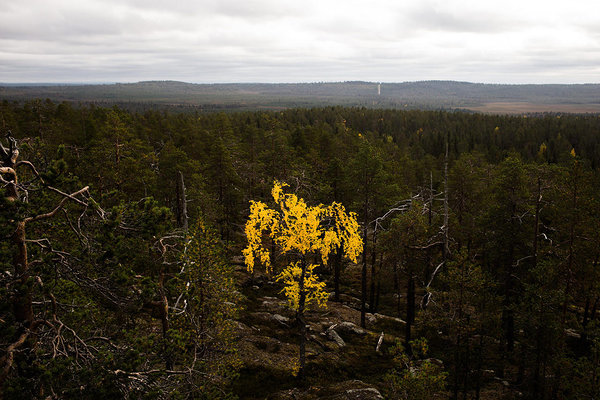Here in Lapland, between summer and winter is a special period when leaves are changing colours as nature is preparing for the upcoming season. This is usually called Ruska, as said in Finnish, meaning The Autumn Colours.
Then why are the leaves changing their colour?
One reason for this is because trees are preparing for winter and storing chlorophyll inside their trunks. This chlorophyll helps trees to grow new leafs again next spring. Chlorophyll is a kind of construction material that trees use when the amount of light and temperature is warm enough to grow new generation of leaves. Commonly trees will destingush it is time for preparations when the amount of light decreases. Also when the temperature begins to lower, trees will realise it is time to store chlorophyll.When chlorophyll disappears, leaves still remain pigmented with shades of red and yellow. At some point these pigments will disperse and the only thing left is brown tannin. Though usually leaves have already fallen down to the ground before this. Some researches have discovered that the red colour especially has been used as a warning for herbivores. Trees are signalling that they are still healthy and able to protect themselves if needed. On the other hand, yellow might allure vermin to feast as colour divulges that nutrients have been withdrawn back into the trunk.
What is the best time to witness this colourful transformation?
Here in Lapland the time for autumn colour is mainly at the same time every year. Different temperatures don’t affect them that much compared to the decreasing amount of light. Quantity of light is constant yearly so for that reason trees are changing colour predictably every year. In most northern parts of Finland this starts in late August and it is at its best during the second week of September. At the Arctic Circle, where we are located, normally the pinnacle of Autumn colour is in the middle of September all the way to early October.What do the autumn colours represent for photographers?
Autumn is a special time for taking great pictures here in Lapland! It is the only season when nature displays this much variation in colour around us. Outside, there’s still plenty of daylight so you don´t have to worry about carrying special equipment what you might need when taking long exposures or light painting. Just your camera and few lenses are usually enough. More importantly than gear, is that as photographers, we always try to seek good composition for our pictures. These awesome colours you see everywhere, such as the terrain and trees, are adept to inspire you in multiple nature photography styles. For example, seeing a single Aspen with red and yellow leaves on an otherwise green backround is definitely a great place for a picture. Or maybe a colourful forest drawing reflections onto the surface of a tranquil lake. Opportunities are almost limitless!Before heading out it is good to prepare windproof clothing and proper shoes. With personal experience, it dosen´t hurt if you also have waterproof clothes in your backpack just in case. Even though the weather could be perfect when you head out, specially in autumn, the possibility of rain is always present. Even if you don´t mind getting wet, your expensive camera definitely does! If it starts to rain, it is strongly recommended to protect your camera and lenses to avoid moisture getting inside them. That might even break them. Also if you´re exploring alone, always make sure that there´s at least the following equipment with you.
- Matches, if you need to light a fire (in waterproof case).
- Some extra clothes, specially socks if you get wet.
- Mobile phone with fully charged battery. Also consider bringing a power bank (for Instagram updates or calling for help if needed using the emergency number 112 in Finland).
Here are some tips to share for photographing autumn colours that you might find usefull.
- Prepare different lenses for different types of scenery. Wide-angle for landscapes and zoom for more detailed subjects.
- Think about the layout of your picture. Sporadic red or yellow tree on an otherwise green and grey backround makes for a particulalry dramatic juxtaposition.
- Look for reflections, these can give you quite a stricking outcome.
- Before you head out, spend a little while thinking about what it is you’re photographing and what interest you might have during the day. (This helps for preparations)
- Have the right equipment to protect you and your camera from getting wet.
The autumn colours are a creative way to increase your skills as a photographer. Also, the enjoyment of nature is really refreshing amidts the hurry and stress of life. Our own autumn photography expeditions might help you to reach great locations and scenery. As a local tour operator, we have good knowledge about the surrounding areas and have many more tips to share with you when it comes to photographing them!
Let´s enjoy the colours together!
Juho UurtamoPhotographer, Beyond Arctic

